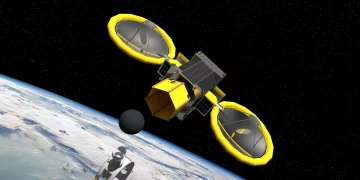Introduction: The Search for Extraterrestrial Intelligence (SETI) and Its Importance
The quest to find extraterrestrial life is one of the most profound and exhilarating challenges in human history. For centuries, humanity has pondered the possibility of life beyond our planet. The Search for Extraterrestrial Intelligence (SETI) is the scientific effort to detect signs of intelligent alien civilizations. Unlike traditional forms of space exploration that aim to explore the solar system or distant galaxies, SETI focuses on listening for signals—radio waves, laser pulses, or other types of electromagnetic radiation—that might indicate the presence of advanced extraterrestrial beings.
SETI’s importance goes far beyond the mere curiosity of discovering life elsewhere. It holds the potential to answer one of the most fundamental questions of all: Are we alone in the universe? The implications of discovering extraterrestrial life would be nothing short of transformative, not only for science but for philosophy, theology, and our understanding of humanity’s place in the cosmos. Moreover, the technology and methods developed in the pursuit of SETI have led to advancements in radio astronomy, data analysis, and artificial intelligence, benefiting a wide range of scientific disciplines.
In this article, we’ll explore the history and methods of SETI, the breakthroughs in the field, and the role of artificial intelligence (AI) in accelerating the search for extraterrestrial life. We will also examine how the discovery of life beyond Earth could change everything we know about our world, our civilization, and our future in space exploration.
Technologies Used in the Search: Radio Telescopes, Optical Telescopes, and the Latest in Detection Technologies
The technologies employed by SETI are as diverse as the questions they seek to answer. From large radio telescopes to cutting-edge optical devices, SETI scientists have developed a sophisticated toolkit for searching for alien signals. One of the primary instruments used in the search is the radio telescope. These massive, parabolic dishes are capable of picking up faint signals across vast distances in space, including those in the microwave and radio wave bands. These wavelengths are ideal for transmitting information over the vast stretches of space, and because radio waves can travel long distances without significant interference, they are one of the most plausible methods for extraterrestrial civilizations to communicate.
One of the most famous radio telescopes used in SETI research is the Arecibo Observatory in Puerto Rico, which, before its collapse in 2020, was a key instrument for detecting extraterrestrial signals. Another prominent example is the Green Bank Telescope in West Virginia, USA, which has been involved in several SETI projects. These telescopes are used to scan large portions of the sky, searching for signals that stand out from the noise of background cosmic radiation.
While radio telescopes dominate the field of SETI, optical telescopes also play a role in detecting alien signals. These telescopes are used to search for laser pulses or other forms of light-based communication. The idea is that extraterrestrial civilizations might use lasers to send directed signals across space, which could be detectable by optical telescopes on Earth. The Laser SETI project, for example, is dedicated to searching for brief but powerful bursts of light that could be artificial in origin.
In addition to these traditional methods, SETI scientists are now utilizing optical SETI techniques, which involve monitoring stars for unusual flashes or anomalies in their light emissions. These flashes could be a form of alien communication, similar to how human civilizations use light signals for communication on Earth (e.g., laser pointers). Optical SETI is an emerging field, and as technology advances, it is expected to become an increasingly important tool in the search for extraterrestrial intelligence.
Moreover, advances in technology have made it possible to scan vast swathes of the sky more efficiently than ever before. New tools, such as wide-field surveys and fast radio bursts (FRBs), have increased the volume of data collected, enhancing SETI’s ability to detect alien signals. The search has become more comprehensive, as scientists now monitor larger portions of the electromagnetic spectrum, from radio waves to optical and even infrared signals.
Exoplanet Discovery and Habitable Zones: How Finding Planets in the Habitable Zone Boosts the Chances of Discovering Life
In recent years, the discovery of exoplanets—planets orbiting stars outside our solar system—has dramatically expanded the search for extraterrestrial life. The study of exoplanets is important because it provides the context within which SETI can search for life. While SETI focuses on detecting alien signals, the discovery of potentially habitable planets offers a much-needed target for those efforts.
One of the key concepts in exoplanet research is the habitable zone—also known as the “Goldilocks Zone.” This is the region around a star where conditions are just right for liquid water to exist on the surface of a planet. Liquid water is considered one of the essential ingredients for life as we know it, so planets within their star’s habitable zone are prime candidates for the search for life.
The most famous example of exoplanet discovery is the Kepler Space Telescope, which has identified thousands of exoplanets since its launch in 2009. Many of these planets are located within their star’s habitable zone. The discovery of planets like Kepler-452b (nicknamed “Earth’s cousin”) has sparked significant interest because they share many similarities with Earth, including their size and distance from their parent star. As more exoplanets are discovered, scientists now have a growing list of potential targets for SETI.
The discovery of exoplanets has also led to the identification of biosignatures—indicators of potential biological activity—on distant worlds. For example, atmospheric compositions that resemble those of Earth, containing gases like oxygen or methane, might suggest the presence of life. These biosignatures could serve as a stepping stone for future SETI projects to focus on certain star systems or exoplanets that show signs of habitability.
As technology advances, astronomers are developing more powerful instruments capable of analyzing the atmospheres of exoplanets with greater precision. Tools like the James Webb Space Telescope (JWST), which is set to launch in the coming years, will allow scientists to probe the chemical composition of distant planets’ atmospheres and potentially identify biomarkers—molecules or conditions that suggest the presence of life.

Breakthroughs in SETI Research: Recent Advancements in SETI’s Efforts to Detect Alien Signals
SETI’s search has not been static. Over the decades, the field has seen significant breakthroughs in terms of both technology and methodology. One of the most notable recent advancements in SETI research came with the discovery of Fast Radio Bursts (FRBs)—extremely powerful and brief flashes of radio waves originating from distant galaxies. FRBs are still not fully understood, and their exact cause remains a mystery. However, their unexpected nature and high energy content have led some researchers to consider the possibility that they could be signals from alien civilizations.
In addition to FRBs, another breakthrough in SETI research was the discovery of ‘Oumuamua, a strange object that passed through the solar system in 2017. Its unusual shape, speed, and trajectory led some scientists to speculate that it could be an alien probe or spacecraft, though this theory remains speculative. Regardless of its origin, ‘Oumuamua sparked renewed interest in the idea that intelligent life could be sending us signals in ways we don’t yet understand.
Another significant development came from the Breakthrough Listen Initiative, a project launched in 2015 that aims to scan the entire sky for radio signals and laser emissions from extraterrestrial civilizations. Using the largest and most advanced radio telescopes, such as the Green Bank Telescope and the Parkes Telescope, the Breakthrough Listen team is capturing and analyzing vast amounts of data. While no signals have been found yet, the initiative has pushed the boundaries of what SETI can accomplish by providing researchers with new resources, funding, and access to the most advanced detection technologies.
The Impact of AI in Alien Search: How Artificial Intelligence is Accelerating the Search for Alien Life
Artificial Intelligence (AI) has revolutionized many aspects of science, and SETI is no exception. The vast amounts of data generated by modern telescopes and detection systems are simply too large for human researchers to analyze manually. AI, particularly machine learning algorithms, is now being used to sift through this data and detect patterns that might indicate the presence of alien signals.
AI systems can detect anomalies in data that might otherwise go unnoticed, and they are particularly effective at identifying “needle-in-a-haystack” signals—those rare and fleeting events that could be extraterrestrial in origin. For example, AI-driven systems can look for signals that differ from the background noise of natural sources, such as cosmic radiation or human-made interference. In some cases, these AI algorithms have already found new patterns of signals that warrant further investigation.
Additionally, AI has been employed to predict which parts of the sky are most likely to produce alien signals. By analyzing patterns in exoplanet data, stellar activity, and cosmic radiation, AI can suggest the best regions of space to focus SETI’s search efforts. The synergy between AI and traditional SETI technologies is creating an exponentially more powerful toolkit for finding extraterrestrial intelligence.
Conclusion: What the Discovery of Extraterrestrial Life Could Mean for Humanity and Space Exploration
The search for extraterrestrial life is not just an academic pursuit; it is an endeavor that could profoundly impact our understanding of the universe and our place within it. The discovery of intelligent alien civilizations would have far-reaching consequences for science, philosophy, and even religion. It would force us to reevaluate our assumptions about life, intelligence, and the potential for life elsewhere in the cosmos.
In the context of space exploration, finding alien life would accelerate humanity’s desire to explore other star
systems and planets. The search would no longer be confined to the search for Earth-like conditions or the study of microbial life. If alien civilizations are found, we would face the unprecedented challenge of contacting and potentially interacting with beings from beyond our world.
Moreover, the technologies developed through SETI, such as advanced radio telescopes, AI algorithms, and methods for detecting exoplanets, will have far-reaching applications beyond the search for alien life. These innovations will help drive future space exploration, improve our understanding of the cosmos, and open new frontiers for scientific discovery.
The search for extraterrestrial life is a journey that transcends our species, a quest for knowledge that unites us in our curiosity and determination to understand the universe. While the discovery of extraterrestrial life remains elusive, each step forward brings us closer to an answer that could forever change the course of humanity’s story in the cosmos.


















































Discussion about this post